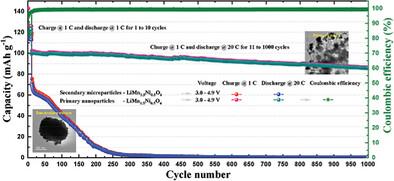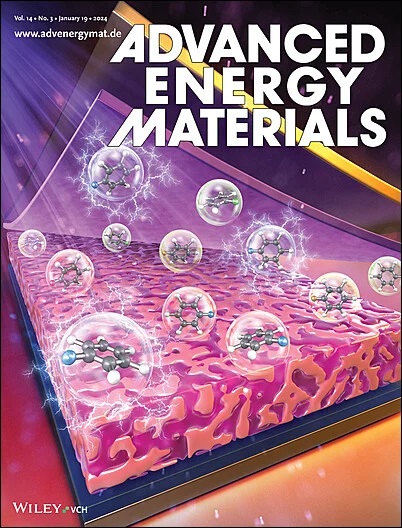IF 24.4
1区 材料科学
Q1 CHEMISTRY, PHYSICAL
引用次数: 0
摘要
二次微粒子是使用 Mn1.5Ni0.5(OH)2CO3 前驱体合成的,该前驱体经过热分解和煅烧,释放出 CO2 和 H2O 气体物种。原位高温相阐释证实,LiMn1.5Ni0.5O4 阴极的无序相程度最低,没有岩盐杂质相,且 Mn3+ 含量极低,具有稳定的 Fd m 结构。拉曼光谱显示在 590 cm-1 处有一条没有分裂的频带(F2g(3)),这证实了无序相尖晶石化合物的存在。显微分析显示,次生微颗粒和分离的原生纳米颗粒具有表面涂层-导电网络结构。与次生微颗粒相比,原生纳米颗粒的循环伏安图在 4.7 V 处显示出两个氧化还原峰,证实了 Ni2+ 到 Ni3+ 和 Ni3+ 到 Ni4+ 氧化还原过程具有卓越的动力学可逆性。在 20C 放电时,分离的原生纳米粒子在 4.3 V 处显示出放电平电压曲线,并在第 12 个循环和第 1000 个循环中分别输出 100 mAh g-1 和 86 mAh g-1 的高可逆容量,而次生微粒子在第 12 个循环中输出 70 mAh g-1 的容量,并在第 250 个循环中衰减,容量为 5 mAh g-1。研究结果证实,这种高耐久性、无钴、高电压阴极具有很大的应用潜力,能够在锂电池中进行高速放电。本文章由计算机程序翻译,如有差异,请以英文原文为准。

In Situ High‐Temperature Phase Elucidation of Secondary Particles and Segregating Nanoparticles with Surface Coating‐Networking Architecture for High‐Voltage Cathode Life at High Rate
Secondary microparticles are synthesized using a Mn1.5 Ni0.5 (OH)2 CO3 precursor, which undergoes thermal decomposition and calcination, releasing CO2 and H2 O gaseous species. In situ high‐temperature phase elucidation confirms the least degree of disordered phase LiMn1.5 Ni0.5 O4 cathode without rock‐salt impurity phase and having insignificant content of Mn3+ to stable Fd m structure. Raman spectrum shows a band at 590 cm−1 (F2g (3) ) without splitting, confirming spinel compound derived with disordered phase. Microscopic analyses reveal secondary microparticles and segregated primary nanoparticles having surface coating‐conducting network architecture. Cyclic voltammograms of primary nanoparticles show well‐resolved two redox peaks at 4.7 V compared to secondary microparticles, confirming superior kinetic reversibility for Ni2+ to Ni3+ and Ni3+ to Ni4+ redox process. At 20C discharge, segregated primary nanoparticles exhibit a discharge flat voltage profile at 4.3 V and deliver a high reversible capacity of 100 mAh g−1 for the 12th cycle and 86 mAh g−1 for the 1000th cycle, while secondary microparticles deliver 70 mAh g−1 for 12th cycle and declined its cycle operation at 250th cycle with the capacity of < 5 mAh g−1 . Results confirm a strong potential for use as a highly durable, cobalt‐free, high‐voltage cathode capable of high‐rate discharge in LIBs.
求助全文
通过发布文献求助,成功后即可免费获取论文全文。
去求助
来源期刊

Advanced Energy Materials
CHEMISTRY, PHYSICAL-ENERGY & FUELS
CiteScore
41.90
自引率
4.00%
发文量
889
审稿时长
1.4 months
期刊介绍:
Established in 2011, Advanced Energy Materials is an international, interdisciplinary, English-language journal that focuses on materials used in energy harvesting, conversion, and storage. It is regarded as a top-quality journal alongside Advanced Materials, Advanced Functional Materials, and Small.
With a 2022 Impact Factor of 27.8, Advanced Energy Materials is considered a prime source for the best energy-related research. The journal covers a wide range of topics in energy-related research, including organic and inorganic photovoltaics, batteries and supercapacitors, fuel cells, hydrogen generation and storage, thermoelectrics, water splitting and photocatalysis, solar fuels and thermosolar power, magnetocalorics, and piezoelectronics.
The readership of Advanced Energy Materials includes materials scientists, chemists, physicists, and engineers in both academia and industry. The journal is indexed in various databases and collections, such as Advanced Technologies & Aerospace Database, FIZ Karlsruhe, INSPEC (IET), Science Citation Index Expanded, Technology Collection, and Web of Science, among others.
 求助内容:
求助内容: 应助结果提醒方式:
应助结果提醒方式:


